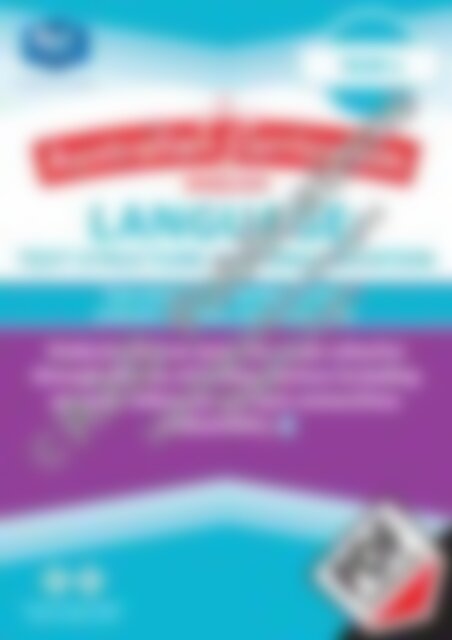20888 ACE Language (Yr 4) Pronoun Reference and Text Connectives
You also want an ePaper? Increase the reach of your titles
YUMPU automatically turns print PDFs into web optimized ePapers that Google loves.
Your partner in education<br />
YEAR 4<br />
ENGLISH<br />
LANGUAGE:<br />
TEXT STRUCTURE AND ORGANISATION<br />
<strong>Text</strong> cohesion <strong>and</strong> linking devices:<br />
pronoun reference, text connectives<br />
Underst<strong>and</strong> how texts are made cohesive<br />
through the use of linking devices including<br />
pronoun reference <strong>and</strong> text connectives<br />
(<strong>ACE</strong>LA1491)<br />
Australian Primary Publisher<br />
of the Year 2015 <strong>and</strong> 2016
Australian Curriculum English – <strong>Language</strong>: <strong>Text</strong> structure <strong>and</strong> organisation (Year 4)<br />
Foreword<br />
Australian Curriculum English – <strong>Language</strong>: <strong>Text</strong> structure <strong>and</strong> organisation (Year 4) is one in a series of seven teacher<br />
resource books that support teaching <strong>and</strong> learning activities in Australian Curriculum English. The books focus on<br />
the sub-str<strong>and</strong> of <strong>Text</strong> structure <strong>and</strong> organisation within the <strong>Language</strong> str<strong>and</strong> of the national English curriculum.<br />
The resource books include theoretical background information, activities to develop the content descriptions, blackline<br />
masters, resource sheets <strong>and</strong> assessment checklists, along with interrelated links to other English str<strong>and</strong>s <strong>and</strong> sub-str<strong>and</strong>s.<br />
Titles in this series are:<br />
• Australian Curriculum English – <strong>Language</strong>: <strong>Text</strong> structure <strong>and</strong> organisation (Foundation)<br />
• Australian Curriculum English – <strong>Language</strong>: <strong>Text</strong> structure <strong>and</strong> organisation (Year 1)<br />
• Australian Curriculum English – <strong>Language</strong>: <strong>Text</strong> structure <strong>and</strong> organisation (Year 2)<br />
• Australian Curriculum English – <strong>Language</strong>: <strong>Text</strong> structure <strong>and</strong> organisation (Year 3)<br />
• Australian Curriculum English – <strong>Language</strong>: <strong>Text</strong> structure <strong>and</strong> organisation (Year 4)<br />
• Australian Curriculum English – <strong>Language</strong>: <strong>Text</strong> structure <strong>and</strong> organisation (Year 5)<br />
• Australian Curriculum English – <strong>Language</strong>: <strong>Text</strong> structure <strong>and</strong> organisation (Year 6)<br />
Contents<br />
Format of this book .................................. iv – v<br />
<strong>Language</strong>: <strong>Text</strong> structure <strong>and</strong><br />
organisation .............................................. 2–77<br />
Underst<strong>and</strong> how texts vary in complexity <strong>and</strong><br />
technicality depending on the approach to the topic,<br />
the purpose <strong>and</strong> intended audience (<strong>ACE</strong>LA1490)<br />
© Australian Curriculum: Assessment <strong>and</strong> Reporting Authority 2012<br />
–Teacher information ................................................. 2<br />
–Activities to develop the content description ....... 3–9<br />
–Blackline masters ............................................. 10–27<br />
–Assessment checklist ............................................. 28<br />
–Interrelated English links ........................................ 29<br />
– Modes, capabilities <strong>and</strong> priorities covered by the<br />
activities in this content description ....................... 29<br />
Underst<strong>and</strong> how texts are made cohesive through the<br />
use of linking devices including pronoun reference <strong>and</strong><br />
text connectives (<strong>ACE</strong>LA1491)<br />
© Australian Curriculum: Assessment <strong>and</strong> Reporting Authority 2012<br />
–Teacher information ............................................... 30<br />
–Activities to develop the content description ......... 31<br />
–Blackline masters <strong>and</strong> resource sheets .............. 32–41<br />
–Assessment checklist ............................................. 42<br />
–Interrelated English links ........................................ 43<br />
– Modes, capabilities <strong>and</strong> priorities covered by the<br />
activities in this content description ....................... 43<br />
Recognise how quotation marks are used in texts<br />
to signal dialogue, titles <strong>and</strong> quoted (direct)<br />
speech (<strong>ACE</strong>LA1492)<br />
© Australian Curriculum: Assessment <strong>and</strong> Reporting Authority 2012<br />
–Teacher information ............................................... 44<br />
–Activities to develop the content description ......... 45<br />
–Blackline masters <strong>and</strong> resource sheets ............. 46–53<br />
–Assessment checklist ............................................. 54<br />
–Interrelated English links ........................................ 55<br />
– Modes, capabilities <strong>and</strong> priorities covered by the<br />
activities in this content description ....................... 55<br />
Identify features of online texts that enhance readability<br />
including text, navigation, links, graphics <strong>and</strong><br />
layout (<strong>ACE</strong>LA1793)<br />
© Australian Curriculum: Assessment <strong>and</strong> Reporting Authority 2012<br />
–Teacher information ............................................... 56<br />
–Activities to develop the content description ......... 57<br />
–Blackline masters <strong>and</strong> resource sheets ............. 58–75<br />
–Assessment checklist ............................................. 76<br />
–Interrelated English links ........................................ 77<br />
– Modes, capabilities <strong>and</strong> priorities covered by the<br />
activities in this content description ....................... 77<br />
Answers .................................................... 78–83<br />
R.I.C. Publications ® www.ricpublications.com.au Australian Curriculum English – <strong>Language</strong>: <strong>Text</strong> structure <strong>and</strong> organisation (Year 4)<br />
iii
Format of the book<br />
This teacher resource book includes supporting materials for teaching <strong>and</strong> learning in the sub-str<strong>and</strong> of <strong>Text</strong> structure<br />
<strong>and</strong> organisation within the str<strong>and</strong> of <strong>Language</strong> in Australian Curriculum English. All content descriptions in the substr<strong>and</strong><br />
have been included, as well as teaching points based on the Curriculum’s elaborations.<br />
While the book focuses on the sub-str<strong>and</strong> of <strong>Text</strong> structure <strong>and</strong> organisation, activities <strong>and</strong> interrelated links to other<br />
str<strong>and</strong>s <strong>and</strong> sub-str<strong>and</strong>s have been incorporated.<br />
Each section supports a specific content description <strong>and</strong> follows a consistent format, containing the following<br />
information over several pages:<br />
• activities to develop the content descriptions • student blackline masters • resource sheets<br />
• interrelated English links<br />
• assessment checklist<br />
Answers relating to student blackline masters have been included at the back of the book.<br />
The length of each content description section varies.<br />
Teacher information includes background information relating to the content description, as well as<br />
related terms <strong>and</strong> desirable student vocabulary <strong>and</strong> other useful details which may assist the teacher.<br />
Related terms includes vocabulary<br />
associated with the content description.<br />
Many of these relate to the glossary<br />
in the back of the official Australian<br />
Curriculum English document;<br />
additional related terms may also have<br />
been added.<br />
Student vocabulary includes words<br />
which the teacher would use—<br />
<strong>and</strong> expect the students to learn,<br />
underst<strong>and</strong> <strong>and</strong> use—during English<br />
lessons.<br />
Further resources by R.I.C.<br />
Publications or other publishers<br />
or authors are included where<br />
appropriate.<br />
? What this means<br />
provides a general<br />
explanation of the content<br />
description.<br />
T Teaching points<br />
provides a list of<br />
the main teaching points<br />
relating to the content<br />
description.<br />
E Elaborations are a<br />
list of elaborations<br />
based on those in the<br />
content description.<br />
Activities to develop the content<br />
description includes descriptions or<br />
instructions for activities or games<br />
relating to the content descriptions<br />
or elaborations. Some activities are<br />
supported by blackline masters or<br />
resource sheets. Where applicable,<br />
these will be stated for easy reference.<br />
Australian Curriculum English – <strong>Language</strong>: <strong>Text</strong> structure <strong>and</strong> organisation (Year 4) www.ricpublications.com.au R.I.C. Publications ®<br />
iv
Format of the book.<br />
Blackline masters <strong>and</strong><br />
resource sheets are provided<br />
to support teaching <strong>and</strong><br />
learning activities for each<br />
content description. These<br />
include worksheets for class<br />
use, games, charts or other<br />
materials which the teacher<br />
might find useful to use or<br />
display in the classroom. For<br />
each blackline master the<br />
content description to which it<br />
relates is given.<br />
Interrelated English links<br />
lists other links covered within<br />
the <strong>Language</strong> str<strong>and</strong>, Literature<br />
str<strong>and</strong> <strong>and</strong> Literacy str<strong>and</strong> of<br />
English that are incorporated in<br />
the activities provided with the<br />
content description. While the<br />
book’s approach focuses on the<br />
<strong>Text</strong> structure <strong>and</strong> organisation<br />
sub-str<strong>and</strong>, the links show the<br />
integration across the three<br />
str<strong>and</strong>s.<br />
Each section has a checklist<br />
which teachers may find useful as<br />
a place to keep a record of their<br />
observations of the activities to<br />
develop the content descriptions.<br />
Answers for student worksheets<br />
are provided at the back of the<br />
book.<br />
A table showing the <strong>Language</strong><br />
modes, General capabilities<br />
<strong>and</strong> Cross-curriculum priorities<br />
covered by the activities in each<br />
content description is provided.<br />
R.I.C. Publications ® www.ricpublications.com.au Australian Curriculum English – <strong>Language</strong>: <strong>Text</strong> structure <strong>and</strong> organisation (Year 4)<br />
v
<strong>Text</strong> structure<br />
<strong>and</strong> organisation<br />
Underst<strong>and</strong> how texts are made cohesive through the use of linking devices including pronoun<br />
reference <strong>and</strong> text connectives (<strong>ACE</strong>LA1491)<br />
© Australian Curriculum: Assessment <strong>and</strong> Reporting Authority 2012<br />
Related terms<br />
<strong>Text</strong>s<br />
Written, spoken or multimodal forms of<br />
communication for a range of purposes. <strong>Text</strong><br />
forms, organisation <strong>and</strong> conventions have been<br />
developed to enhance effective communication.<br />
Cohesion<br />
Grammatical or lexical relationships that make<br />
links between different parts of a text <strong>and</strong> hold<br />
it together. Cohesion is achieved through devices<br />
such as paragraphs, connectives, ellipses <strong>and</strong><br />
word associations.<br />
Linking devices<br />
Devices used to connect different parts of a text,<br />
including paragraphs, connectives, ellipses <strong>and</strong><br />
word associations.<br />
<strong>Text</strong> connectives<br />
Words which link paragraphs <strong>and</strong> sentences in<br />
logical relationships of time, cause <strong>and</strong> effect,<br />
comparison or addition. <strong>Connectives</strong> relate ideas<br />
<strong>and</strong> help to show the logic of the information.<br />
Conjunctions<br />
Words that join other words, phrases <strong>and</strong> clauses<br />
in logical relationships such as time, cause <strong>and</strong><br />
comparison.<br />
Word associations<br />
The semantical relationships between words<br />
which form links within texts.<br />
Synonyms<br />
Words with the same or similar meaning.<br />
Antonyms<br />
Words with the opposite meaning.<br />
Noun phrase<br />
A noun with all its modifi ers <strong>and</strong> determiners.<br />
<strong>Pronoun</strong> reference<br />
The word a pronoun is replacing <strong>and</strong> referring to.<br />
Student vocabulary<br />
?<br />
T<br />
E<br />
What this means<br />
Teacher information<br />
• <strong>Text</strong>s only make sense because of the ways in which the separate parts are linked to<br />
form a cohesive whole.<br />
• Students need to recognise, underst<strong>and</strong> <strong>and</strong> use linking devices including pronoun<br />
reference <strong>and</strong> connectives in written texts.<br />
Teaching points<br />
• There can be many ideas in text, but they will only make sense to the reader if he/<br />
she can see how they are connected.<br />
• Writers show how things in a text are connected in many different ways.<br />
• <strong>Connectives</strong> are cohesive devices because they are used to link information, ideas,<br />
characters, events etc. in text <strong>and</strong> to show how they are connected.<br />
• Time connectives are used to link sections of text by sequencing events.<br />
• Word associations such as synonyms <strong>and</strong> antonyms make text more cohesive, add<br />
interest <strong>and</strong> can add meaning.<br />
• <strong>Pronoun</strong>s are used as synonyms to refer back to nouns <strong>and</strong> phrases in text, avoiding<br />
unnecessary repetition.<br />
Elaborations<br />
E1. Identifying <strong>and</strong> using different ways of naming the same thing, including word<br />
associations such as synonyms <strong>and</strong> antonyms, noun phrases <strong>and</strong> pronoun reference,<br />
<strong>and</strong> underst<strong>and</strong>ing that these devices provide cohesion, <strong>and</strong> add interest, variety <strong>and</strong><br />
meaning.<br />
E2. Identifying <strong>and</strong> using connectives as cohesive devices to link sentences <strong>and</strong><br />
paragraphs <strong>and</strong> to sequence through time.<br />
Further resources<br />
• This interactive is a ‘Hangman’<br />
type of challenge in which students have to identify common time connectives.<br />
connectives<br />
time connectives<br />
conjunctions<br />
paragraph<br />
compare<br />
contrast<br />
cause<br />
effect<br />
pronoun<br />
Australian Curriculum English – <strong>Language</strong>: <strong>Text</strong> structure <strong>and</strong> organisation (Year 4) www.ricpublications.com.au R.I.C. Publications ®<br />
30
<strong>Text</strong> structure<br />
<strong>and</strong> organisation<br />
Underst<strong>and</strong> how texts are made cohesive through the use of<br />
linking devices including pronoun reference <strong>and</strong> text connectives<br />
(<strong>ACE</strong>LA1491)<br />
© Australian Curriculum: Assessment <strong>and</strong> Reporting Authority 2012<br />
Activities to<br />
develop the<br />
content description<br />
E1. Identifying <strong>and</strong> using different ways of naming the same thing, including word associations such as<br />
synonyms <strong>and</strong> antonyms, noun phrases <strong>and</strong> pronoun reference, <strong>and</strong> underst<strong>and</strong>ing that these devices<br />
provide cohesion, <strong>and</strong> add interest, variety <strong>and</strong> meaning.<br />
• Concept wheel (page 32)<br />
Graphic organisers like a concept wheel can be useful for organising information into paragraphs. Each part of the concept wheel can be labelled <strong>and</strong><br />
notes about that particular aspect of a topic added. Students can write two of the paragraphs outlined on the wheel before considering how they are<br />
related. They then modify their fi rst sentence of one to start with a connective showing how they are linked. This process should fi rst be modelled a<br />
number of times.<br />
Students can work with a partner or individually.<br />
• Same thing - different names (page 33)<br />
The two texts on this page model the use of interesting <strong>and</strong> descriptive nouns <strong>and</strong> word phrases. Students are required to replace these with a common<br />
or proper noun <strong>and</strong> to refl ect on the effect this has on the text.<br />
• What’s wrong? (page 34)<br />
In the text on this activity page the names Bill <strong>and</strong> Ben are consistently used instead of using word associations <strong>and</strong> pronouns. This is to demonstrate to<br />
the students how strange such a text would be. They are required to state why it doesn’t ‘sound right’ <strong>and</strong> to replace these two proper nouns with noun<br />
groups <strong>and</strong> pronouns. They then review their new text <strong>and</strong> assess it.<br />
• <strong>Pronoun</strong> meaning (page 35)<br />
This multiple choice activity page gives students some practice in identifying the word(s) each pronoun is referring to.<br />
• Changing words (page 36)<br />
Students are required to replace highlighted words in a text with one of the given choices. They evaluate their new text. Some activities on antonyms are<br />
included <strong>and</strong> they then rewrite the text to change its meaning.<br />
Interrelated English links: See page 43<br />
E2. Identifying <strong>and</strong> using connectives as cohesive devices to link sentences <strong>and</strong> paragraphs <strong>and</strong> to<br />
sequence through time.<br />
• What’s the connection? (page 37)<br />
Students identify connectives joining two given sentences.<br />
• <strong>Connectives</strong> (page 38)<br />
This resource sheet explaining different types of connectives <strong>and</strong> conjunctions can be projected <strong>and</strong> used with students or used as a teacher reference.<br />
• Visit to Disneyl<strong>and</strong> – 1 (page 39)<br />
The text, ‘Visit to Disneyl<strong>and</strong>’, can be used with the corresponding activity page to provide practice in identifying time connectives sentences in<br />
paragraphs <strong>and</strong> sentences.<br />
• Visit to Disneyl<strong>and</strong> – 2 (page 40)<br />
Students identify time connectives <strong>and</strong> complete related activities.<br />
• Visit to Disneyl<strong>and</strong> – 3 (page 41)<br />
Students select suitable words to use as connectives on this page. There are a number of possible alternatives for some sentences, but they may only use<br />
a word once.<br />
Interrelated English links: See page 43<br />
R.I.C. Publications ® www.ricpublications.com.au Australian Curriculum English – <strong>Language</strong>: <strong>Text</strong> structure <strong>and</strong> organisation (Year 4)<br />
31
Concept wheel<br />
Resource sheet<br />
Underst<strong>and</strong> how texts are made cohesive through the use of linking devices including pronoun reference <strong>and</strong> text connectives (<strong>ACE</strong>LA1491)<br />
© Australian Curriculum: Assessment <strong>and</strong> Reporting Authority 2012<br />
Australian Curriculum English – <strong>Language</strong>: <strong>Text</strong> structure <strong>and</strong> organisation (Year 4) www.ricpublications.com.au R.I.C. Publications ®<br />
32
Same thing – different names<br />
1. (a) Read the paragraph <strong>and</strong> highlight all the words <strong>and</strong> phrases you could<br />
replace with the words, ‘an elephant’, ‘the elephant’ or ‘elephants’.<br />
Elephants are mammals. These enormous creatures are the Earth’s largest l<strong>and</strong><br />
mammals. The only mammals that are bigger than them are whales. They are<br />
usually gentle <strong>and</strong> they can be trained to work hard. But it is not a good idea to<br />
hurt one or to make it angry. When one of these gentle giants is angry, it can be<br />
very dangerous. People who have hurt one of them have been attacked a long<br />
time later. They say this is because they never forget.<br />
Underst<strong>and</strong> how texts are made cohesive through the use of linking devices including pronoun reference <strong>and</strong> text connectives (<strong>ACE</strong>LA1491)<br />
© Australian Curriculum: Assessment <strong>and</strong> Reporting Authority 2012<br />
(b) Write ‘an elephant’ or ‘elephants’ above all your highlighted words <strong>and</strong><br />
read the new text to a partner.<br />
(c) Give your opinion about the new text by circling one of the word choices.<br />
I think the new text is:<br />
(i) easier harder to underst<strong>and</strong>. (ii) more less interesting.<br />
(iii) shorter longer . (iv) more less informative.<br />
2. (a) Read the paragraph <strong>and</strong> highlight all the words <strong>and</strong> phrases you could<br />
replace with the word ‘Caleb’.<br />
Caleb was always in trouble. It didn’t matter how hard he tried, things always<br />
seemed to go wrong for the poor boy. One day his dad planted a new veggie<br />
garden. As he was going to have a shower, he asked his son to give the plants a<br />
bit of water. His willing helper picked up the hose. He had great fun pretending<br />
it was a firehose. The happy fireman worked really hard putting out an enormous<br />
fire. Then he heard Dad coming back. The busy waterer looked at Dad’s garden.<br />
What had he done? Then … the terrified boy realised he had washed away every<br />
one of Dad’s new veggie plants.<br />
(b) Write ‘Caleb’ above all your highlighted<br />
words <strong>and</strong> read the new text to a partner.<br />
(c)<br />
Explain how the new text is different from the old one.<br />
R.I.C. Publications ® www.ricpublications.com.au Australian Curriculum English – <strong>Language</strong>: <strong>Text</strong> structure <strong>and</strong> organisation (Year 4)<br />
33
What’s wrong?<br />
1. (a) Read the text <strong>and</strong> think about why it doesn’t sound right.<br />
Bill <strong>and</strong> Ben are twins. Bill <strong>and</strong> Ben like to do the same things. One afternoon Bill<br />
<strong>and</strong> Ben were helping Bill <strong>and</strong> Ben’s dad cook dinner. He was making his famous<br />
stew. One of the things Bill <strong>and</strong> Ben liked doing was chopping up the vegetables<br />
to put in the stew. Bill <strong>and</strong> Ben’s dad said Bill <strong>and</strong> Ben could do this if Bill <strong>and</strong> Ben<br />
were very careful with the knives he gave Bill <strong>and</strong> Ben. Bill <strong>and</strong> Ben added Bill<br />
<strong>and</strong> Ben’s vegetables to the stew. Then Bill <strong>and</strong> Ben’s dad’s phone rang. Bill <strong>and</strong><br />
Ben’s dad went away to talk. Bill <strong>and</strong> Ben knew Bill <strong>and</strong> Ben’s dad liked hot stew<br />
so Bill <strong>and</strong> Ben added some hot spices. Bill put in the chilli then Bill’s twin added<br />
the same. Ben put in some pepper <strong>and</strong> Ben’s brother added Bill’s too. Bill <strong>and</strong> Ben<br />
continued adding the same spices until Dad returned, then Bill <strong>and</strong> Ben left. Mum<br />
was very pleased that dinner was ready when Bill <strong>and</strong> Ben’s mum got home. Bill<br />
<strong>and</strong> Ben’s mum took one mouthful, Bill <strong>and</strong> Ben’s mum’s face went red <strong>and</strong> Bill<br />
<strong>and</strong> Ben’s mum raced to get some water. Bill <strong>and</strong> Ben<br />
<strong>and</strong> Bill <strong>and</strong> Ben’s dad had all added the same spices …<br />
<strong>and</strong> was it hot!<br />
(b) Explain what’s wrong with it.<br />
(c)<br />
Change all the Bill <strong>and</strong> Ben words so it sounds better. Write your new words<br />
above Bill <strong>and</strong> Ben. Try to make the text more interesting by using words such<br />
as ‘the twins’ or ‘the silly boys’ as well as pronouns such as ‘they’ <strong>and</strong> ‘them’.<br />
(d) Circle one word.<br />
My new text: (i) is more interesting/boring.<br />
(ii) takes more/less space?<br />
(iii) makes it easier/harder to underst<strong>and</strong>.<br />
(iv) gives more/less information.<br />
Australian Curriculum English – <strong>Language</strong>: <strong>Text</strong> structure <strong>and</strong> organisation (Year 4) www.ricpublications.com.au R.I.C. Publications ®<br />
34<br />
Underst<strong>and</strong> how texts are made cohesive through the use of linking devices including pronoun reference <strong>and</strong> text connectives (<strong>ACE</strong>LA1491)<br />
© Australian Curriculum: Assessment <strong>and</strong> Reporting Authority 2012
<strong>Pronoun</strong> meaning<br />
1. What does the pronoun ‘it’ in this sentence mean?<br />
‘Your room’s really messy <strong>and</strong> I’m angry about it’, Mum complained.<br />
(a) the child (b) Mum (c) the mess<br />
2. The pronoun ‘this’ means:<br />
Kai ate his burger <strong>and</strong> then declared that this was what he wanted to eat for tea every<br />
night.<br />
(a) tea (b) a burger (c) what he wanted<br />
Underst<strong>and</strong> how texts are made cohesive through the use of linking devices including pronoun reference <strong>and</strong> text connectives (<strong>ACE</strong>LA1491)<br />
© Australian Curriculum: Assessment <strong>and</strong> Reporting Authority 2012<br />
3. The pronoun ‘it’ means:<br />
The atmosphere which is thickest near the Earth’s surface begins to thin out until it<br />
eventually becomes space.<br />
(a) space (b) the atmosphere<br />
(c)<br />
the Earth’s surface<br />
4. What does the pronoun ‘these’ refer to?<br />
‘Are these yours, Juan?’ asked the teacher, holding up a pair of really dirty socks.<br />
(a) the dirty socks (b) Juan (c) the teacher<br />
5. What are ‘those’?<br />
‘Don’t include any of those’, said Mum, pointing to the very ripe bananas.<br />
(a) the shopkeeper (b) the ripe bananas<br />
(c)<br />
Mum pointing<br />
6. The word ‘that’ means:<br />
‘Do you think that was such a good idea?’<br />
Dad asked my sister when she left her dolls’<br />
pram in the middle of the road.<br />
(a)<br />
a good idea<br />
(b) leaving the pram<br />
(c)<br />
the middle of the road<br />
R.I.C. Publications ® www.ricpublications.com.au Australian Curriculum English – <strong>Language</strong>: <strong>Text</strong> structure <strong>and</strong> organisation (Year 4)<br />
35
Changing words<br />
1. (a) Read the paragraph about Jason <strong>and</strong> the<br />
golden fleece <strong>and</strong> choose some new words<br />
from the box with the same meaning to replace<br />
the highlighted ones. Write the new words<br />
above the ones they’re replacing.<br />
grateful man<br />
the beautiful bird<br />
The clever captain<br />
the brave sailors<br />
the poor man’s<br />
the greedy creatures<br />
There was an old blind king on an isl<strong>and</strong> where Jason <strong>and</strong> his crew stopped for<br />
supplies. Some horrible flying creatures called Harpies were stealing his food.<br />
Jason tricked the Harpies <strong>and</strong> saved the king from his misery. In return, the king<br />
told them how to escape the clashing rocks they had to sail their ship through.<br />
They let a white dove fly ahead <strong>and</strong> followed it to safety.<br />
(b) How have the new words changed the text?<br />
(c)<br />
Do you think the new text or the original text is better?<br />
(d) Why?<br />
2. (a) Choose 10 words from the story <strong>and</strong> write them <strong>and</strong> their opposites.<br />
(b) Write the story on a separate page using words with the opposite<br />
meaning.<br />
Underst<strong>and</strong> how texts are made cohesive through the use of linking devices including pronoun reference <strong>and</strong> text connectives (<strong>ACE</strong>LA1491)<br />
© Australian Curriculum: Assessment <strong>and</strong> Reporting Authority 2012<br />
Australian Curriculum English – <strong>Language</strong>: <strong>Text</strong> structure <strong>and</strong> organisation (Year 4) www.ricpublications.com.au R.I.C. Publications ®<br />
36
What’s the connection?<br />
A text makes sense because the sentences in it are linked or connected in some<br />
way. The words connecting sentences <strong>and</strong> paragraphs are called ‘connectives’.<br />
For example: ‘Therefore’ <strong>and</strong> ‘in fact’ have been used to connect two of these<br />
sentences.<br />
I had studied for the test. Therefore, I was upset when I didn’t do well.<br />
My father plays golf very well. In fact, he was the club champion last year.<br />
1. Circle the connective linking the two sentences.<br />
Underst<strong>and</strong> how texts are made cohesive through the use of linking devices including pronoun reference <strong>and</strong> text connectives (<strong>ACE</strong>LA1491)<br />
© Australian Curriculum: Assessment <strong>and</strong> Reporting Authority 2012<br />
(a)<br />
It was a really rough windy day. So, we decided it would be too dangerous<br />
to take our boat out.<br />
(b) We all had fun playing games at the birthday party. However, the food was<br />
very disappointing <strong>and</strong> there wasn’t enough of it.<br />
(c)<br />
The b<strong>and</strong> played some of our favourite music, the musicians played very<br />
well <strong>and</strong> the lead guitarist had a really good voice. In summary, the b<strong>and</strong><br />
was fantastic.<br />
(d) My sister loves to play sport <strong>and</strong> is very good at it. By contrast, my brother<br />
would much rather sit <strong>and</strong> play on his computer.<br />
(e)<br />
(f)<br />
The play seemed to be going on forever. Finally, it was over, the curtain<br />
came down <strong>and</strong> I could go home.<br />
Most of the team have a chest infection. Consequently, they may have to<br />
forfeit tomorrow’s game.<br />
(g) The wolf locked Gr<strong>and</strong>mother in the cupboard <strong>and</strong> climbed into bed.<br />
Meanwhile, Little Red Riding Hood was getting closer <strong>and</strong> closer to<br />
Gr<strong>and</strong>mother’s house.<br />
(h) I just love strawberry ice-cream. On the other h<strong>and</strong>, I just can’t st<strong>and</strong> sweet,<br />
sticky strawberry jam.<br />
(i)<br />
(j)<br />
It was one of those horrible wet winter days <strong>and</strong><br />
we were feeling cold <strong>and</strong> miserable. Despite this,<br />
our football team went out <strong>and</strong> won the gr<strong>and</strong><br />
final.<br />
The teacher had told the students in her class many<br />
times they could not go outside <strong>and</strong> play unless<br />
they wore their hats. Nevertheless, there were<br />
always one or two of them who tried to do it.<br />
R.I.C. Publications ® www.ricpublications.com.au Australian Curriculum English – <strong>Language</strong>: <strong>Text</strong> structure <strong>and</strong> organisation (Year 4)<br />
37
<strong>Connectives</strong><br />
Resource sheet<br />
<strong>Connectives</strong> are words used in a text to connect the things that happen in one<br />
sentence or paragraph with what happens in another one.<br />
1. <strong>Connectives</strong> can be used to give additional information.<br />
For example:<br />
I think horses are very intelligent <strong>and</strong> beautiful. In fact, they are my favourite animals.<br />
2. <strong>Connectives</strong> can be used to compare or contrast information.<br />
For example:<br />
I was late for school because of the bad weather. For the same reason, my dad took<br />
twice as long as usual to drive to work.<br />
I love sweet food especially ice-cream <strong>and</strong> chocolate. My sister, by contrast, really<br />
enjoys savoury food like pizza <strong>and</strong> olives.<br />
3. <strong>Connectives</strong> can be used to explain cause or effect.<br />
For example:<br />
I left my hat at home. Consequently, I wasn’t allowed to play on the oval at lunchtime.<br />
Time connectives are connectives used in a text to explain when things happen<br />
<strong>and</strong>/or the order in which they happen.<br />
For example:<br />
We usually have our tea at about six o’clock.<br />
After tea, we have to finish our homework. Then, we’re allowed to watch television.<br />
Conjunctions are a type of connective. They are words used to join ideas, words,<br />
phrases <strong>and</strong> sentences.<br />
For example:<br />
• fish <strong>and</strong> chips<br />
• not cheap, but worth every cent<br />
• The rain didn’t bother me because I had an umbrella.<br />
Australian Curriculum English – <strong>Language</strong>: <strong>Text</strong> structure <strong>and</strong> organisation (Year 4) www.ricpublications.com.au R.I.C. Publications ®<br />
38<br />
Underst<strong>and</strong> how texts are made cohesive through the use of linking devices including pronoun reference <strong>and</strong> text connectives (<strong>ACE</strong>LA1491)<br />
© Australian Curriculum: Assessment <strong>and</strong> Reporting Authority 2012
Visit to Disneyl<strong>and</strong> – 1<br />
Underst<strong>and</strong> how texts are made cohesive through the use of linking devices including pronoun reference <strong>and</strong> text connectives (<strong>ACE</strong>LA1491)<br />
© Australian Curriculum: Assessment <strong>and</strong> Reporting Authority 2012<br />
1.<br />
2.<br />
3.<br />
4.<br />
5.<br />
6.<br />
7.<br />
8.<br />
9.<br />
10.<br />
Last year I went to Disneyl<strong>and</strong> with Mum, Dad <strong>and</strong> my little sister. We all had<br />
the best time. Even Mum, who said she really didn’t want to go, enjoyed it.<br />
There were heaps of things to do there <strong>and</strong> the rides were awesome.<br />
Our hotel was close to the park, so we walked to the entrance. As a result, we<br />
were some of the first people there. I couldn’t believe my eyes. Soon there<br />
were people everywhere <strong>and</strong> such a lot of things happening. There were<br />
parades with b<strong>and</strong>s playing <strong>and</strong> Disney characters st<strong>and</strong>ing everywhere.<br />
Dad looked at the map. There was so much on it. It was amazing. He said we<br />
had to get started or we wouldn’t see half of it. Before we knew what was<br />
happening he was racing off to Frontierl<strong>and</strong> <strong>and</strong> we were following.<br />
As soon as he saw Big Thunder Mountain he stopped. Then he rushed <strong>and</strong><br />
stood in the line. We all stood there with him. Although she lined up with<br />
us, Mum said later she had no idea what she was going to be doing. Dad,<br />
however, knew all about it. One of his friends had told him.<br />
Before long we were sitting in a train <strong>and</strong> moving slowly away from the<br />
platform <strong>and</strong> climbing. Then, we picked up speed. It was exciting <strong>and</strong> scary.<br />
We raced around sharp bends as we came down the mountain. Poor Mum was<br />
in shock as she held on <strong>and</strong> screamed at every sharp turn.<br />
Eventually the train stopped <strong>and</strong> we got off. I looked at Mum wondering<br />
what she was going to say. ‘What’s next?’ she asked. ‘I would never have gone<br />
on that ride if I had known what it was like. But now I’ve done it <strong>and</strong> survived,<br />
I’m ready for the next one.’<br />
‘Who is this lady <strong>and</strong> what’s happened to my mum?’ I muttered.<br />
With Mum leading the way, we went from attraction to attraction. Some, like<br />
Splash Mountain, were really scary <strong>and</strong> my little sister wasn’t tall enough to<br />
go on them. Others, like the paddle-steamer were very gentle. Her favourite<br />
was ‘It’s a Small World’, where the same music was repeated over <strong>and</strong> over.<br />
Dad looked very pleased when it finished <strong>and</strong> he wouldn’t let her do it again.<br />
Finally, <strong>and</strong> very reluctantly, we left. It was dark <strong>and</strong> we were all exhausted. But<br />
what a terrific day we’d had! Every thing was so well organised. The staff, they’re<br />
called ‘the cast’, were very friendly <strong>and</strong> helpful. There were loads of places<br />
to eat or to just rest between the wonderful rides.<br />
Since we’ve been home, we’ve been trying<br />
to persuade Mum <strong>and</strong> Dad to take<br />
us back. However, now we<br />
know one day just<br />
wouldn’t be long<br />
enough.<br />
R.I.C. Publications ® www.ricpublications.com.au Australian Curriculum English – <strong>Language</strong>: <strong>Text</strong> structure <strong>and</strong> organisation (Year 4)<br />
39
Visit to Disneyl<strong>and</strong> – 2<br />
Read the text on page 39 <strong>and</strong> answer the questions about the time connectives<br />
used to link sentences <strong>and</strong> paragraphs.<br />
1. (a) The two time connectives used in Paragraph 5 are:<br />
<strong>and</strong><br />
(b) Which one is used to link two paragraphs?<br />
(c)<br />
Which one links two sentences?<br />
2. (a) The time connective used in Paragraph 6 is<br />
(b) Is this time connective linking paragraphs? Yes<br />
No<br />
3. Tick the time connective used in Paragraph 8.<br />
(a)<br />
was repeated over <strong>and</strong> over<br />
(b) when it finished<br />
(c)<br />
he wouldn’t let her do it again<br />
4. (a) What is the time connective used in Paragraph 2?<br />
(b) Another time connective that the writer could<br />
have used instead of this one is:<br />
5. Add some interesting time connectives to this paragraph.<br />
we had finished on Splash Mountain we went to find<br />
the Indiana Jones ride in Adventurel<strong>and</strong>. It was very dark <strong>and</strong> spooky inside <strong>and</strong> there<br />
were lots of screaming mummies <strong>and</strong> giant snakes.<br />
We looked around.<br />
yellow submarine, ride would be a good idea.<br />
we thought a quieter ride would be a good idea.<br />
we decided that Finding Nemo, a<br />
Underst<strong>and</strong> how texts are made cohesive through the use of linking devices including pronoun reference <strong>and</strong> text connectives (<strong>ACE</strong>LA1491)<br />
© Australian Curriculum: Assessment <strong>and</strong> Reporting Authority 2012<br />
Australian Curriculum English – <strong>Language</strong>: <strong>Text</strong> structure <strong>and</strong> organisation (Year 4) www.ricpublications.com.au R.I.C. Publications ®<br />
40
Visit to Disneyl<strong>and</strong> – 3<br />
Choose words from the box to use as connectives to link the paragraphs <strong>and</strong><br />
sentences below.<br />
however therefore nevertheless in addition by contrast<br />
in summary similarly for example in fact in other words<br />
1. There is so much to see <strong>and</strong> do at Disneyl<strong>and</strong>. The rides are awesome, the food is<br />
great, the staff are friendly <strong>and</strong> it is such a fun place. ,<br />
I think it’s wonderful.<br />
2. I think every child should visit Disneyl<strong>and</strong> at least once. ,<br />
Underst<strong>and</strong> how texts are made cohesive through the use of linking devices including pronoun reference <strong>and</strong> text connectives (<strong>ACE</strong>LA1491)<br />
© Australian Curriculum: Assessment <strong>and</strong> Reporting Authority 2012<br />
I realise that getting there is very expensive <strong>and</strong> I know I’m so lucky that my parents<br />
could take me.<br />
3. Splash Mountain is a very scary ride. , Thunder Mountain<br />
makes people scream <strong>and</strong> hold on tight.<br />
4. We stayed close to Disneyl<strong>and</strong> <strong>and</strong> walked there. , it<br />
seemed a very long walk back that night when we were all tired.<br />
5. Our whole family enjoyed Disneyl<strong>and</strong> <strong>and</strong> found lots of things<br />
to do. There are great rides to suit everyone there.<br />
, very young children can go on<br />
'It’s a Small World' <strong>and</strong> older people can relax going down the<br />
river <strong>and</strong> listening to some great music on a paddle-steamer.<br />
6. It is difficult to decide which rides to take at Disneyl<strong>and</strong> <strong>and</strong> where to eat. The choices<br />
are so varied <strong>and</strong> interesting.<br />
to this, there are hundreds<br />
of wonderful, friendly staff there to help you. No wonder they call it ‘The happiest<br />
place on Earth’.<br />
7. Use any one of the words from the box to connect two sentences about your<br />
opinion of going to visit Disneyl<strong>and</strong>.<br />
R.I.C. Publications ® www.ricpublications.com.au Australian Curriculum English – <strong>Language</strong>: <strong>Text</strong> structure <strong>and</strong> organisation (Year 4)<br />
41
<strong>Text</strong> structure<br />
<strong>and</strong> organisation<br />
Underst<strong>and</strong> how texts are made cohesive through the use of<br />
linking devices including pronoun reference <strong>and</strong> text connectives<br />
(<strong>ACE</strong>LA1491)<br />
© Australian Curriculum: Assessment <strong>and</strong> Reporting Authority 2012<br />
Assessment<br />
checklist<br />
Student Name<br />
Identifi es word<br />
associations used as<br />
linking devices<br />
Uses appropriate<br />
word associations<br />
such as synonyms<br />
<strong>and</strong> antonyms to add<br />
variety <strong>and</strong> interest<br />
to text<br />
Identifi es <strong>and</strong> uses<br />
pronoun reference<br />
Identifi es <strong>and</strong> uses<br />
connectives to<br />
link sentences <strong>and</strong><br />
paragraphs<br />
Identifi es <strong>and</strong> uses<br />
time connectives<br />
appropriately<br />
Underst<strong>and</strong>s<br />
that connectives<br />
contribute to text<br />
coherence<br />
Australian Curriculum English – <strong>Language</strong>: <strong>Text</strong> structure <strong>and</strong> organisation (Year 4) www.ricpublications.com.au R.I.C. Publications ®<br />
42
<strong>Text</strong> structure<br />
<strong>and</strong> organisation<br />
Underst<strong>and</strong> how texts are made cohesive through the use of<br />
linking devices including pronoun reference <strong>and</strong> text connectives<br />
(<strong>ACE</strong>LA1491)<br />
© Australian Curriculum: Assessment <strong>and</strong> Reporting Authority 2012<br />
Interrelated<br />
English<br />
links<br />
Below is a list of links within the <strong>Language</strong> str<strong>and</strong>, Literature str<strong>and</strong> <strong>and</strong> Literacy str<strong>and</strong> of English that are covered within the activities provided with the<br />
content description above:<br />
E1. Identifying <strong>and</strong> using different ways of naming the same thing, including word associations such as<br />
synonyms <strong>and</strong> antonyms, noun phrases <strong>and</strong> pronoun reference, <strong>and</strong> underst<strong>and</strong>ing that these devices<br />
provide cohesion, add interest, variety <strong>and</strong> meaning.<br />
• Underst<strong>and</strong> that the meaning of sentences can be enriched through the use of noun groups/phrases <strong>and</strong> prepositional phrases (<strong>ACE</strong>LA1493)<br />
• Incorporate new vocabulary from a range of sources into students’ own texts including vocabulary encountered in research (<strong>ACE</strong>LA1498)<br />
• Underst<strong>and</strong> how to use strategies for spelling words, including spelling rules, knowledge of morphemic word families, spelling generalisations, <strong>and</strong> letter<br />
combinations including double letters (<strong>ACE</strong>LA1779)<br />
• Use comprehension strategies to build literal <strong>and</strong> inferred meaning to exp<strong>and</strong> content knowledge, integrating <strong>and</strong> linking ideas <strong>and</strong> analysing <strong>and</strong><br />
evaluating texts (<strong>ACE</strong>LY1692)<br />
• Reread <strong>and</strong> edit for meaning by adding, deleting or moving words or word groups to improve content <strong>and</strong> structure (<strong>ACE</strong>LY1695)<br />
• Write using clearly-formed joined letters, <strong>and</strong> develop increased fl uency <strong>and</strong> automaticity (<strong>ACE</strong>LY1696)<br />
E2. Identifying <strong>and</strong> using connectives as cohesive devices to link sentences <strong>and</strong> paragraphs <strong>and</strong> to sequence<br />
through time.<br />
• Underst<strong>and</strong> how to use strategies for spelling words, including spelling rules, knowledge of morphemic word families, spelling generalisations, <strong>and</strong> letter<br />
combinations including double letters (<strong>ACE</strong>LA1779)<br />
• Use comprehension strategies to build literal <strong>and</strong> inferred meaning to exp<strong>and</strong> content knowledge, integrating <strong>and</strong> linking ideas <strong>and</strong> analysing <strong>and</strong><br />
evaluating texts (<strong>ACE</strong>LY1692)<br />
• Reread <strong>and</strong> edit for meaning by adding, deleting or moving words or word groups to improve content <strong>and</strong> structure (<strong>ACE</strong>LY1695)<br />
• Write using clearly-formed joined letters, <strong>and</strong> develop increased fl uency <strong>and</strong> automaticity (<strong>ACE</strong>LY1696)<br />
The above links are reproduced with permission from ACARA.<br />
© Australian Curriculum: Assessment <strong>and</strong> Reporting Authority 2012<br />
Modes, capabilities <strong>and</strong> priorities covered by the<br />
activities in this content description<br />
<strong>Language</strong> modes<br />
Listening<br />
General capabilities<br />
Literacy<br />
✔<br />
Speaking<br />
Reading<br />
Viewing<br />
Writing<br />
✔<br />
✔<br />
Numeracy<br />
Information <strong>and</strong> communication<br />
technology (ICT) capability<br />
Critical <strong>and</strong> creative thinking<br />
Personal <strong>and</strong> social capability<br />
Ethical behaviour<br />
Intercultural underst<strong>and</strong>ing<br />
Cross-curriculum priorities<br />
Aboriginal <strong>and</strong> Torres Strait Isl<strong>and</strong>er histories <strong>and</strong> cultures<br />
Asia <strong>and</strong> Australia’s engagement in Asia<br />
Sustainability<br />
R.I.C. Publications ® www.ricpublications.com.au Australian Curriculum English – <strong>Language</strong>: <strong>Text</strong> structure <strong>and</strong> organisation (Year 4)<br />
43
<strong>Text</strong> structure<br />
<strong>and</strong> organisation<br />
Underst<strong>and</strong> how texts are made cohesive through the use of<br />
linking devices including pronoun reference <strong>and</strong> text connectives<br />
(<strong>ACE</strong>LA1491)<br />
© Australian Curriculum: Assessment <strong>and</strong> Reporting Authority 2012<br />
Answers<br />
Same thing - different names ....................... page 33<br />
1. (a) Elephants are mammals. These enormous creatures are the Earth’s<br />
largest l<strong>and</strong> mammals. The only mammals that are bigger than<br />
them are whales. They are usually gentle <strong>and</strong> they can be trained to<br />
work hard. But it is not a good idea to hurt one or to make it angry.<br />
When one of these gentle giants is angry, it can be very dangerous.<br />
People who have hurt one of them have been attacked a long time<br />
later. They say this is because they never forget.<br />
(b) Elephants are mammals. Elephants are the Earth’s largest l<strong>and</strong><br />
mammals. The only mammals that are bigger than elephants are<br />
whales. Elephants are usually gentle <strong>and</strong> elephants can be trained<br />
to work hard. But it is not a good idea to hurt an elephant or to<br />
make it angry. When an elephant is angry, the elephant can be very<br />
dangerous. People who have hurt an elephant have been attacked<br />
a long time later. They say this is because elephants never forget.<br />
(c) Teacher check<br />
2. (a) Caleb was always in trouble. It didn’t matter how hard he tried,<br />
things always seemed to go wrong for the poor boy. One day<br />
his dad planted a new veggie garden. As he was going to have<br />
a shower, he asked his son to give the plants a bit of water. His<br />
willing helper picked up the hose. He had great fun pretending<br />
it was a fi rehose. The happy fi reman worked really hard putting<br />
out an enormous fi re. Then he heard Dad coming back. The busy<br />
waterer looked at Dad’s garden. What had he done? Then … the<br />
terrifi ed boy realised he had washed away every one of Dad’s new<br />
veggie plants.<br />
(b) Caleb was always in trouble. It didn’t matter how hard Caleb tried,<br />
things always seemed to go wrong for Caleb. One day Caleb’s dad<br />
planted a new veggie garden. As he was going to have a shower,<br />
he asked Caleb to give the plants a bit of water. Caleb picked up<br />
the hose. Caleb had great fun pretending it was a fi rehose. Caleb<br />
worked really hard putting out an enormous fi re. Then Caleb heard<br />
Dad coming back. Caleb looked at Dad’s garden. What had Caleb<br />
done? Then … Caleb realised Caleb had washed away every one of<br />
Dad’s new veggie plants.<br />
(c) Teacher check<br />
What’s wrong? ............................................... page 34<br />
Teacher check<br />
<strong>Pronoun</strong> meaning .......................................... page 35<br />
1. (c) the mess<br />
2. (b) a burger<br />
3. (b) the atmosphere<br />
4. (a) the dirty socks<br />
5. (b) the ripe bananas<br />
6. (b) leaving the pram<br />
Changing words ............................................. page 36<br />
1. (a) There was an old blind king on an isl<strong>and</strong> where Jason <strong>and</strong> his crew<br />
stopped for supplies. Some horrible fl ying creatures called Harpies<br />
were stealing the poor man’s food. The clever captain tricked the<br />
greedy creatures <strong>and</strong> saved the king from his misery. In return,<br />
the grateful man told them how to escape the clashing rocks the<br />
brave sailors had to sail their ship through. They let a white dove fl y<br />
ahead <strong>and</strong> followed the beautiful bird to safety.<br />
(b)–(d) Teacher check<br />
2. (a)–(b) Teacher check<br />
What’s the connection? ................................. page 37<br />
1. (a) So<br />
(b) However<br />
(c) In summary<br />
(d) By contrast<br />
(e) Finally<br />
(f) Consequently<br />
(g) Meanwhile<br />
(h) On the other h<strong>and</strong><br />
(i) Despite this<br />
(j) Nevertheless<br />
Visit to Disneyl<strong>and</strong> – 2 ................................... page 40<br />
1. (a) Before long, Then<br />
(b) Before long<br />
(c) Then<br />
2. (a) Eventually<br />
(b) Yes<br />
3. (b) when it fi nished<br />
4. (a) Soon<br />
(b) Answers may include: Before long, Then, Suddenly<br />
5. Teacher check<br />
Visit to Disneyl<strong>and</strong> – 3 ................................... page 41<br />
Answers will vary.<br />
1. In summary<br />
2. However<br />
3. Similarly<br />
4. By contrast/Nevertheless<br />
5. For example<br />
6. In addition<br />
7. Teacher check<br />
Australian Curriculum English – <strong>Language</strong>: <strong>Text</strong> structure <strong>and</strong> organisation (Year 4) www.ricpublications.com.au R.I.C. Publications ®<br />
80


















